National Cuizine
э але где моя забивная картинка
 Posted by
xinavo
Posted by
xinavo

 Posted by
senioruymeow
Posted by
senioruymeow

 Posted by
senioruymeow
Posted by
senioruymeow
My croissant recipe is here.
I'm preparing the ingredients we'll need.
In the bowl of the combine combine the sifted flour, salt, sugar, yeast and the nozzle "hook" mix everything for a minute.
Then I add cold water and milk and knead the dough for 3-4 minutes at a minimum speed, it should come together in a lump.
In small pieces, I add 40 g of butter at room temperature and continue kneading the same way, at minimum speed, for another 4-5 minutes.
You will notice how over time the dough will change, become soft, homogeneous, not sticky, and will gather into one lump. Do not knead for a long time, as you will overheat.
I roll out the dough into a rectangle, approximately 15x30 cm in size, and transfer it to a board dusted with flour. There is also a little flour and a film on top. Leave for 30 minutes at room temperature.
After the time has elapsed, I wrap the dough well with cling film and put it in the refrigerator for 5-6 hours. In general, it is possible for a day.
Oil for the interlayer.
From parchment paper I make an envelope with an inner square of 15x15 cm . I put a piece of softened butter (140 g) in the center and distribute it with my hands.
The oil must be tested, with a fat content of at least 82%, and preferably 84%. If you are not sure about the quality of the oil, you can add flour to it: 10% of the amount of oil. That is, for 140 g of butter – 14 g of flour.
I distribute the oil around the perimeter of the square in an even layer. I put it in the refrigerator until needed.
After the time has elapsed, the dough and butter are ready to work. I take it out of the refrigerator and give it 2-3 minutes to warm up. During the time spent in the refrigerator, the dough practically does not increase – this is normal. At a low temperature, the yeast sleeps.
On the work surface, I roll out the dough 2 times more than the oil layer. I spread the oil on one half, it is cooled, but quite plastic.
I pinch well
 Posted by
senioruymeow
Posted by
senioruymeow